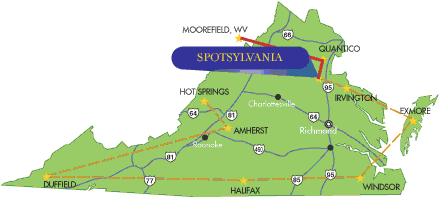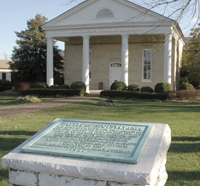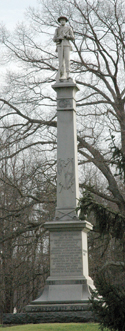Download
in PDF Format
A
community defined by both its past and its future.
Once upon a time, as they used to say
in children�s books, there was an old wagon road from the town of
Orange
that crossed a large county called Spotsylvania where another dirt road
from
Fredericksburg
joined it.
Nothing much happened at that sleepy
intersection until an inn was built there in 1838, followed by the
establishment of the county courthouse at that site a year later.
The crossroads became an important
stopover on what was then a long trip from the outlying rural counties to
the state capital in
Richmond
. Life was good in the center of this stable farming
county until May of 1864, when the sky fell on it. From that day and for
the next two weeks, the full brunt of one of the most terrible
bloodlettings in American history came down on Spotsylvania Courthouse and
became the first defining event in its history.
|

The
Spotsylvania Courthouse has a long history, originating at
Germanna Ford on the Rapidan River inn 1722, when the still-large
county extended considerably further west. |
The second one began quite peacefully
in the last two decades of the 20th century and is ongoing. It is no less
than a transformation of the county and the courthouse community at its
center.
The common denominator, the thread
that links the horror of the Battle of Spotsylvania Courthouse in 1864
with the literal reconfiguring of this scenic 411-square-mile county and
the community at its center is the people who live in and around it.
For reasons no one can quite remember,
this small town of a few hundred to as much as a thousand or more souls
(depending upon where some imaginary line is drawn) has never been
incorporated and is not one of
Virginia
�s official towns.
Never mind. It is very much a
community, a place whose
residents love it and can�t imagine living anywhere else.
And while Fredericksburg, much larger
and perhaps more widely renowned for historical events lies just 10 miles
to the north, long-time county residents (as opposed to the flood of new
arrivals elsewhere in Spotsylvania) strongly identify with their county
and with the courthouse community of the same name.
Leota Pendleton, who is 84, moved to
Spotsylvania Courthouse with her husband, Jim, in 1950. They �bought a
little filling station-grocery store.� Business was good, they raised a
family and ran the store, expanding it and building a hardware store on
the same site over the years.
|

Lone
Confederate Sentry guards the graves of more than 600 mostly
Confederate soldiers buried in the cemetery half a mile north of
the old courthouse. |
The family sold the grocery some years
ago but Pendleton�s son, Bob, continues to operate Pendleton�s
Hardware, a classic example of the independent hardware stores once found
in small towns across
America
.
Pendleton talks with a reporter about
the prospects for his business in a time when big chain stores are taking
over. As he talks, a customer comes in and holds up an inch-long rubber
part, needing a replacement.
The veteran hardware man not only
knows what it is but what the man needs to make the repair, and tells him
precisely where he must look for both the model and serial numbers he
needs. And in that genial moment Bob Pendleton makes the case and seals
the bid for keeping those independent hardware stores in the game.
Pendleton and many others seem well
aware of the second invasion of
Spotsylvania
and know that this one is changing the county permanently.
Just down the street from
Pendleton�s, behind the venerable Chewnings store at the crossroads,
next to the new county tourism center, several acres of land have been
scraped bare.
Bob Kurtinitis, a retiree who loves
history and works with tourists, points out the bulldozed site, where a
new shopping center will soon be built.
Between there and the woods to the
north of it � hallowed, untouchable land of the Spotsylvania portion of
the Fredericksburg and Spotsylvania National Military Park � Kurtinitis
says a new bypass is to be built.
A visitor standing on the steps of the
historic Spotswood Inn at 5 o�clock on any weekday afternoon looks
straight down a long line of backed-up traffic at the town�s single
stoplight. The people in those vehicles are, for the most part, recently
arrived commuters heading home to subdivisions west and south of the
courthouse. Will the bypass hurt business? Pendleton
says probably not much.
Change on the Horizon
So much change is happening or poised
to happen so fast in
Spotsylvania
that it is hard to keep up. In the five years from 2000 to 2005,
Spotsylvania was the second-fastest-growing county in
Virginia
, with more than 116,000 residents, and a growth rate of 28 percent. That
kind of change keeps the county government scrambling, and the little
L-shaped town where Robert E. Lee once camped with his army is the nerve
center of that government.
The county board of supervisors must
try to keep pace with an enormous demand for new infrastructure and
services, which also means a bigger government to operate the whole thing.
That translates into building major new facilities for courts, law
enforcement, fire and rescue and other services at the courthouse.
Doug Barnes, deputy county
administrator, says the county is making a major effort to plan this
expansion with a campus master plan, a historic-preservation district and
citizen commission. Among many improvements called for is a sidewalk to
facilitate walking in a part of the district, due for construction this
spring.
The new walkway will end just past the
Spotsylvania County Museum, where guides enjoy explaining hundreds of
artifacts and exhibits, many of them tied to the nearby 1864 battle, which
turned the area into a killing field as some 30,000 fell.
Depending on the visitor�s
interests, guide Jane Marra can show items as diverse as the fife of a
New Hampshire
youth who died after the Spotsylvania battle, quilts that predate the
Civil War, the huge cast made from the track of a dinosaur in a county
quarry, or an item from the Navy�s Aegis missile cruiser
Chancellorsville
.
Visitors come from far and wide, says
Marra, �but it�s a little slow in wintertime.�
 l
The Christ Episcopal Church, built in 1840 in the Federal style,
has been lovingly preserved and among its displays is a Bible
dating to 1754. l
The Christ Episcopal Church, built in 1840 in the Federal style,
has been lovingly preserved and among its displays is a Bible
dating to 1754. |
The Rev. Jeff Packard, rector of
Christ Episcopal Church, says there is a strong sense of community among
four local churches and their members. Packard, who says he grew up in a
small and isolated town in
Pennsylvania
, notes that it is the members who make a church, �and the people here
are great.�
�I was attracted to the whole
area,� he says, �It is a beautiful area and it�s kind of fascinating
to be connected to the battle here.
Packard says
Christ
Church
, built in 1841, was turned into a battlefield hospital and still shows
damage from the fighting.
Supervisor T.C. Waddy, whose
Livingston District includes the courthouse area, is a native of
Spotsylvania
. �It�s a nice place with nice people,� says Waddy, a former sheriff
in the county.
�The town goes way back before the
Civil War,� says Waddy. �It was a crossroads then and it is still a
crossroads for many people.�